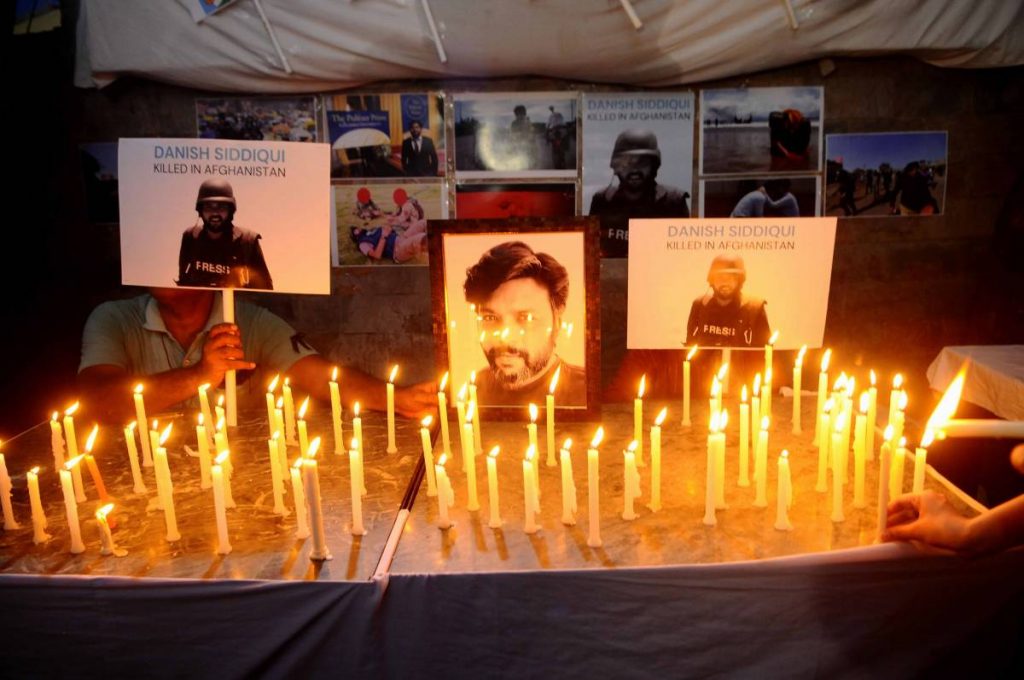Siddiqui was alive when the Taliban captured him. The Taliban verified Siddiqui’s identity and then executed him, as well as those with him. The commander and the remainder of his team died as they tried to rescue him … writes Michael Rubin
On July 16, Pulitzer Prize-winning photojournalist Danish Siddiqui, the chief photographer for Reuters in India, was killed in Afghanistan.His death made headline news around the world. “He was embedded with a convoy of Afghan forces that was ambushed by Taliban militants near a key border post with Pakistan,” the BBC reported. He “was killed while covering a clash between Afghan security forces and the Taliban,” the New York Times wrote.
He “was killed in what was described as Taliban crossfire,” the Washington Post explained. Reuters itself gave a bare-bones account and said, “We are urgently seeking more information [and] working with authorities in the region.” The State Department, meanwhile, said, “We are deeply saddened to hear that Reuters photojournalist Danish Siddiqui was killed while covering fighting in Afghanistan.”

The circumstances of Siddiqui’s death are now clear. He was not simply killed in a crossfire, nor was he simply collateral damage; rather, he was brutally murdered by the Taliban.
Local Afghan authorities say that Siddiqui traveled with an Afghan National Army team to the Spin Boldak region to cover fighting between Afghan forces and the Taliban to control the lucrative border crossing with Pakistan. When they got to within one-third of a mile of the customs post, a Taliban attack split the team, with the commander and a few men separated from Siddiqui, who remained with three other Afghan troops.
During this assault, shrapnel hit Siddiqui, and so he and his team went to a local mosque where he received first aid. As word spread, however, that a journalist was in the mosque, the Taliban attacked. The local investigation suggests the Taliban attacked the mosque only because of Siddiqui’s presence there.
Siddiqui was alive when the Taliban captured him. The Taliban verified Siddiqui’s identity and then executed him, as well as those with him. The commander and the remainder of his team died as they tried to rescue him.
While a widely circulated public photograph shows Siddiqui’s face recognizable, I reviewed other photographs and a video of Siddiqui’s body provided to me by a source in the Indian government that show the Taliban beat Siddiqui around the head and then riddled his body with bullets.
Siddiqui, of course, was doing his job: documenting newsworthy events. It was a risky job, but he took normal precautions that, across countries and battlefields, generally suffice to protect journalists. As for the Afghan National Army: It gave Siddiqui permission to cover the fighting near Spin Boldak because Afghan forces believed they would win. Documenting a victory could provide a much-needed morale boost.
The Taliban’s decision to hunt down, execute Siddiqui, and then mutilate his corpse shows that they do not respect the rules of war or conventions that govern the behaviour of the global community. There are many parallels between the Khmer Rouge and the Taliban. Both infused radical ideology with racist animus. The Taliban are always brutal but likely took their cruelty to a new level because Siddiqui was Indian. They also want to signal that Western journalists are not welcome in any Afghanistan they control and that they expect Taliban propaganda to be accepted as truth. In effect, Siddiqui’s murder appears to show that the Taliban have concluded that their pre-9/11 mistake was not that they were cruel and autocratic but rather that they were not violent or totalitarian enough.

The real question for journalists is why the State Department continues to pretend that Siddiqui’s death was just a tragic accident.
The Biden administration’s decision to uphold the Feb. 29, 2020, U.S.-Taliban agreement even though the Taliban have not, and to withdraw completely, is condemning Afghanistan to a bloodbath. It threatens to destabilize the broader region. But rather than confront reality, the Biden administration appears intent to whitewash Taliban crimes. To acknowledge the fact that the Taliban executed Siddiqui and that the photographer’s death was not a tragic accident would contradict White House spin.
If only successive administrations focused more on defeating the Taliban rather than absolving them or projecting sincerity onto them, the situation might never have become so dire.
(The article was first appeared in Washington Examiner. Michael Rubin (@Mrubin1971) is a contributor to the Washington Examiner’s Beltway Confidential. He is a senior fellow at the American Enterprise Institute.)

Leave a Reply